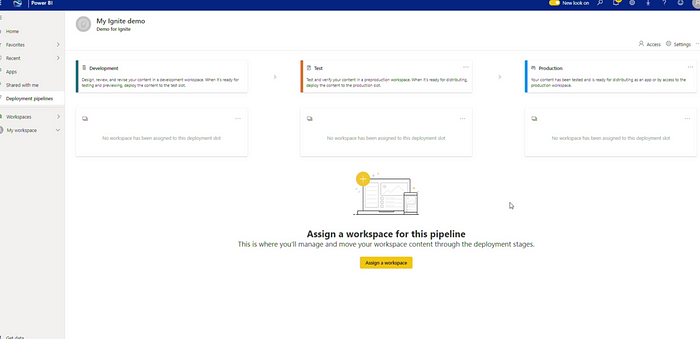Below is my summary of the THR3096 — The future of content life cycle management in Power BI by Nimrod Shalit.

THR3096 — The future of content life cycle management in Power BI
“Have you ever experienced when deploying new content or updating content to Power BI to your end users or to your production environment that your heart is beating a bit faster? 😰 or that your stress level is suddenly rising up?” — Nimrod Shalit

As Power BI usage continues to rise, so does the demand from business users for more new features and new ways to explore data. Also, they usually don’t have too much patience to wait for that new feature to come.

Hey I saw another sales department report with visual 1, 2, 3. They are really cool. Can I have them? Can I have them by tomorrow because I have a presentation next week with a customer?
Why is data only getting refreshed only in the morning? Why can’t it be refreshed on an hourly basis or a 5 min basis?
Why can’t I see hourly breakdown of customer inquiries today up to 19:50? Didn’t we move to the cloud or something?
The requirements can vary a lot but eventually it becomes mostly getting more powerful visuals, more data to be consumed, while obviously meeting the SLA of always being available and reliable. All of that creates an immense load and challenge for the BI department.
Data Driven Investor | Microsoft Having An 'Edge' Over Chrome
A Brief History I was never a fan of browsers, well to be exact I was only a fan of one, Chrome. It has been my…
To be able to meet those requirements the BI department needs to strive for Operational Excellence, the ability to execute fast and with high quality.

Process — is needed for operational excellence because usually in medium sized or larger organizations or when analytics is an important part of your organization, it is not enough to have a BI Engineer to manage all of the BI part end to end. You need to have specific people with expertise: BI Engineers to build beautiful visualizations in reports and dashboards, Data Engineers and Architects to manage and build models and data flows, and BI Managers to oversee all of that.
Tools — to support your process, introducing the Power BI deployment pipeline

THR3096 — The future of content life cycle management in Power BI
Power BI deployment pipelines is a tool to support BI departments in their process of shipping new content or updated content, from Development to Production, to their end-users in an efficient and reusable way.
Enterprises need proper ALM functionality to support the development, testing, and roll out of strategic BI applications. This Power BI Premium-only feature gives enterprises the ability to maintain development, test, and production environments and incrementally transition artifacts between them, re-configuring them with the appropriate connections and security settings.

With Power BI deployment pipelines, your BI creators can improve their productivity by focusing most of their time on their expertise and what they do best.
You will be able to deliver content updates much faster and reduce the errors in repetitive manual work because you will be able to configure reusable settings for development, test, and production environments and then deploy again and again and again.

Navigating in the Deployment Pipeline
There will be a new menu on the left called Deployment pipelines.


1. Create a pipeline

Click on ‘Create a new pipeline’
Enter Pipeline name
Enter Description
2. Assign your workspace

Assign a workspace with content for each slot with content that you can then manage and take it all the way from Development into Production inside Power BI.


Development > Test > Production
Pipeline indicators

means the content between the pipelines are identical

means the content between pipelines do not match and are not identical
When there’s been changes between the deployment pipelines, you can click on “compare” to see the artifact by artifact comparison so that you can easily and quickly understand exactly what happened and what changes were made.

Slot configurations
Use the slot configuration settings to define how your content is updated whenever you deploy to <this> slot.
Dataset rules configuration
Dataset rules allow you to configure for specific parameters and data sources in a dataset.

Datasource rules and parameter rules
Create rules to define parameter values and data sources for this dataset. These rules will be applied when you deploy to <this> slot.

The Power BI Deployment pipeline is scheduled to be on Public Preview this month, May 2020! 😃 Hopefully this features comes out as scheduled! 🤞
New and planned features for Power BI, 2020 release wave 1 - Power Platform Release Plan
This topic lists features that are planned to release from April 2020 through September 2020. Because this topic lists…
In summary, The Power BI Deployment pipeline is a tool that will help you manage your content all the way from Development to Production in a collaborative environment.
You can create multiple Power BI deployment pipelines that can be shared with others.
You can easily deploy content and copy it or overwrite it across your Development, Test, and Production environments.
You can easily and quickly understand the changes or updates made by others to approve or deny for the next deployment pipeline.
You can configure the Parameters and Datasource rules settings for each of the environment to keep the connections to the data or definitions of the query parameters or any other filters.
This is a Power BI Premium-only feature.

